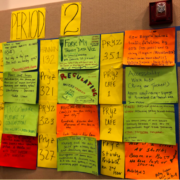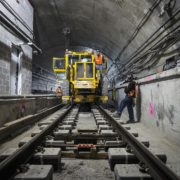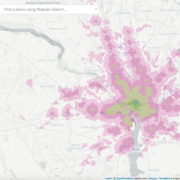
It’s crucial for the public to have data on transportation so they can be informed participants in government decision-making.
Continue readingTransparency can help transit agencies earn public trust

A number of transit agencies face crises of public confidence, and greater transparency can help address this.
Continue readingYou don’t have to be tech-savvy to benefit from open data

Open data can help you even if you know nothing about data, because it can power tools and resources that are usable by anyone.
Continue readingHow the Indian rail website accidentally stops bribery
Sunlight's in India for the Coalition Against Corruption Summit, but one of the most interesting ideas about corruption came to us as we tried to book train tickets.
Continue readingDisappearmarks: How highway projects get left behind
In 1991 the Alabama Department of Transportation (ALDOT) received a $14.6 million federal earmark to reconstruct a highway interchange in downtown Mobile. After spending a portion of the funds on feasibility studies, engineers found that the project would require a great deal of additional federal and state money to complete. What’s more, their studies showed the proposed improvements would only increase highway speeds by an average of five miles per hour.
So they halted the project. And nineteen years later, $10.6 million of that original earmark remains unused ... Continue reading
Reporter’s Notebook: How we got the latest FTA disappearmark data
When we first reported about how we attempted to track down disappearmarks from the Federal Transit Administration, we recounted the difficulties in getting data in an electronic format. In response to our first Freedom of Information request, we were given a 121-page printout of a database, which in the end didn’t accurately include the information we sought: which SAFETEA-LU earmarks went unspent.
When our story ran, the FTA contacted us and said that one reason that FOIA requests are often returned in a printout and not a database form is to allow for the FOIA office to redact or ...
Disappearmarks: Millions in SAFETEA-LU transit earmarks are unspent
Nearly $120 million in Federal Transit Administration earmarks that were introduced and approved by Congress have sat untouched in FTA accounts for years and have now lapsed, according to an FTA list.
The list of unallocated earmarks, which the Sunlight Foundation Reporting Group obtained through a Freedom of Information Act request, show that funds for these projects should have been used by September 30, 2009 at the latest, but due to various reasons, were never spent. (See spreadsheet below for the full list. Some projects appear ... Continue reading
Disappearmarks: Buffalo’s Switcheroo saves earmark

Time was running out for an $11.8 million federal earmark to redevelop the Inner Harbor of the Buffalo River where it empties into Lake Erie. Like most earmarks, the recipient – the Erie Canal Harbor Development Corporation – had only three years to spend the funds before the money lapsed. In Buffalo, that meant the corporation had until October 2007, or else lose it for good.
There were once grand plans for the ... Continue reading
Case study in trying to analyze earmark data
Each year, Congress allocates billions in earmarks that come in the form of annual appropriation committee requests or are attached to various bills that become law. The Sunlight Foundation thought it would be interesting to examine which earmarks, after all the Congressional debate and bluster has dispensed, actually get spent.
We thought a good example would be the $23 billion in transportation earmarks from SAFETEA-LU, The Safe, Accountable, Flexible, Efficient Transportation Equity Act: A Legacy for Users. The act authorized spending on highways, transit systems, port facilities, bus routes and other projects from its passage in August 2005 to what ...
From earmark to disappearmark: Bush administration policy shift cut funding for congressional projects
In 2005, Rep. David Price, D-N.C., earmarked more than $19.6 million to launch a light rail project in his district—one that he had promised to continue his “strong support for” by finding additional federal funding though his position on the House Appropriations Committee.
The light rail project was authorized by SAFETEA-LU, a law enacted in 2005 that was notable for the billions in earmarks it funded—including questionable projects like the “bridges to nowhere” in Alaska and the Prairie Parkway in Illinois.
Yet the light rail project Price sought funding for was ... Continue reading




